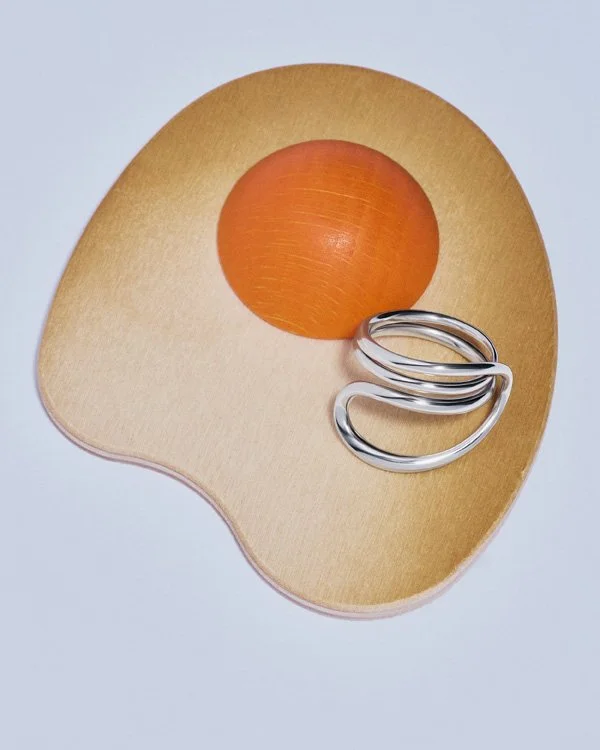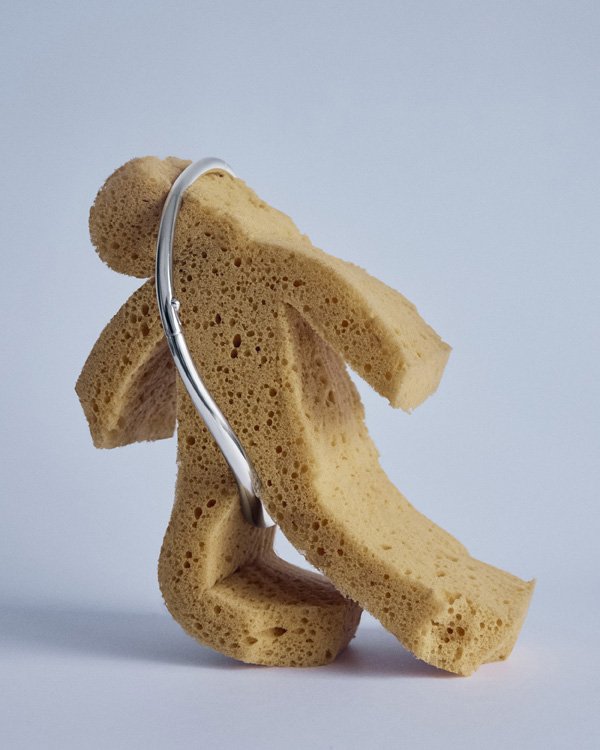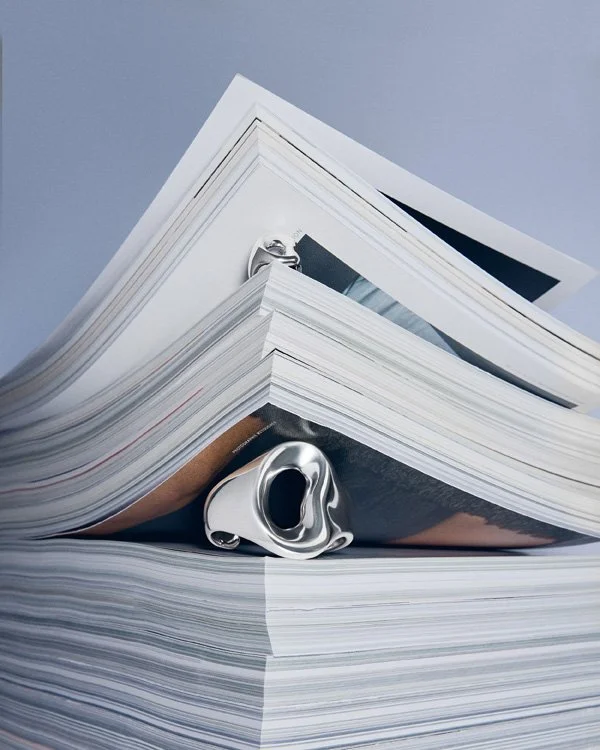CHARLOTTE CHESNAIS
PHOTOGRAPHY THOMAS ROUSSET
INTERVIEW CAROLINE RYAN
THERE IS SOMETHING PROVOCATIVE ABOUT A DECEPTIVELY SIMPLE PIECE OF JEWELLERY. A RING OR EARRING THAT CATCHES YOUR EYE AND LURES YOU IN AND IT IS THIS MAGNETIC QUALITY PRESENT ACROSS ALL OF CHARLOTTE CHESNAIS’ JEWELLERY. THE PARIS-BASED JEWELLERY DESIGNER STRETCHES THE IMAGINATION TO CREATE COILING, FLUID PIECES THAT SEEM TO GROW AND CURL AROUND THE NECK, EARS, AND FINGERS. INTERLACING, WINDING, AND INTERACTING WITH THE BODY TO CREATE AN ALMOST UNENDING DIALOGUE. IMBUED WITH A DISTINCT YET DISCIPLINED RHYTHM, THERE IS A FRISSON OF SENSUALITY WOVEN THROUGHOUT CHESNAIS’ WORK. THE VERY FACT THAT YOUR EYE MUST TRAVEL THE LENGTH OF A PIECE AS IT WRAPS AROUND THE EAR OR A FINGER IS AS REVEALING AS IT IS ALLURING.
SHE “PURSUES HER OWN SENSE OF BALANCE” TO CREATE JEWELLERY THAT IS AT ONCE OBJECT AND ADORNMENT. COMING ALIVE ON THE BODY BUT LIVING AS A SCULPTURE OFF OF IT.
CHARLOTTE CHESNAIS PETIT ROUND TRIP RING
CHARLOTTE CHESNAIS BISEAU BRACELET
CHARLOTTE CHESNAIS WAVE NECKLACE
CHARLOTTE CHESNAIS LASSO BRACELET
CHARLOTTE CHESNAIS BISEAU RING
CHARLOTTE CHESNAIS SHIMA RINGSHIMA CUFF BRACELET
CHARLOTTE CHESNAIS ORIGINAL BINARY CHAIN - SHORT NECKLACE
CHARLOTTE CHESNAIS WAVE BLOW EARRINGS
YOUR JEWELLERY IS SEEMINGLY SIMPLE, BUT THE MORE YOU STUDY A PIECE, THE MORE YOU SENSE A RHYTHM AND SENSUALITY IN THE DESIGN. HOW DO YOU APPROACH CREATING SOMETHING NEW?
It really depends. Sometimes an image will spark a sketch, which might lead to a first prototype as I explore volumes. There’s no set process. Ideas tend to trigger themselves in response to what I see or experience. It’s not something I can fully control.
WHAT DREW YOU TO WORKING WITH THE MATERIALS YOU DO?
It was a natural evolution. In the beginning, I couldn’t afford to work with solid gold, but as the brand grew and I matured, I developed a desire for more timeless pieces made from enduring materials, the finest quality of diamonds and pearls and 18k gold. It all happened quite organically. That said, I did start working with gold fairly early on, but the urge to fully commit to it came around three or four years ago.
YOU’VE DESCRIBED YOUR WORK AS HAVING A NEO-CLASSICAL ELEMENT TO IT. HOW DO YOU GO ABOUT DESIGNING SOMETHING ‘TIMELESS’ THROUGH A MODERN LENS?
That’s exactly my goal, though I’m not sure I succeed every time. That’s the real challenge: creating something so classic and familiar that it’s instantly desirable, while also making it feel entirely new. Many pieces of jewellery today are beautiful but heavily reference the 1920s or ‘30s — which doesn’t resonate as much with me creatively. I’m more interested in building my own references. Since I’m essentially my own first test subject; (and a working mother!) I naturally create pieces I want to wear in my everyday life.
DO YOU HAVE ANY RITUALS IN THE STUDIO — WAYS YOU PREPARE YOURSELF TO START CREATING?
Not really a ritual, but I do like to be alone, to feel like I have a few uninterrupted hours ahead of me. I often listen to classical music, it helps put me in the right headspace. When I’m researching or browsing through books, it’s all quite simple and instinctive.
AT WHAT POINT DO YOU KNOW WHEN A PIECE IS ‘DONE’?
Sometimes it only takes one or two tries, and sometimes it takes twelve. I just know. I feel it when I stop wanting to touch it. Usually, I need to wear it for a few hours or days to be sure. And sometimes, I come back to pieces I initially dismissed and find myself being more forgiving with time.
WHAT ROLE DOES IMPERFECTION PLAY IN YOUR WORK?
It really depends — imperfection and perfection are very subjective. I’d say I always aim for something that feels perfect to me. It might look imperfect to someone else, but to me, it has to feel resolved. Creation isn’t mathematics, there are no right or wrong answers. I pursue my own sense of balance.
WHAT’S A MATERIAL, MEDIUM, OR SCALE YOU HAVEN’T YET EXPLORED BUT WOULD LIKE TO?
I’d love to design a watch; even though it’s quite close to jewellery in terms of material and scale, it’s an object that fascinates me. I’ve also worked with wood on a larger scale for a few projects and for packaging, which I find really interesting. I’m curious about many materials. Often, encountering new craftsmanship triggers creative ideas. If I went to Murano, I know I’d want to work with blown glass.
WHAT ARE THE CHALLENGES OF WORKING IN FASHION OR LEATHER GOODS VERSUS JEWELLERY?
It’s not really a challenge, because when I work with other houses, I place myself at the service of their identity: their codes and DNA. As a designer, my job is to harmonize and bring all these elements together. But when the brand I’m working with shares a similar aesthetic to mine, it can be more complicated, I have to consciously draw a boundary between their world and my own.
YOUR COLLABORATIONS RANGE FROM JEWELLERY TO INTERIOR OBJECTS. WHAT EXCITES YOU ABOUT STEPPING INTO SOMEONE ELSE’S UNIVERSE?
What excites me is creating something that neither brand could’ve done alone. That’s when a collaboration becomes truly interesting. I could never have created CARROUSEL (https://www.christofle.com/eu_fr/carrousel) on my own, it involved very specific savoir-faire. And I don’t think Christofle would’ve designed that piece either. We met halfway. That’s the kind of collaboration I find meaningful.
WHAT DO YOU HOPE SOMEONE FEELS WHEN THEY WEAR A PIECE OF YOUR WORK?
I hope it sparks emotion. I believe my pieces evoke strong responses (positive or negative!) and they’re quite sensual, so there’s a lot of interaction. In a way, they’re like armor, not in a combative sense, but as a form of protection. The first people who wore my pieces often had a strong sense of self; they made the effort to find the jewellery, which showed a certain commitment.
YOU’VE DESCRIBED YOUR JEWELLERY AS SOMETHING THAT SITS BETWEEN OBJECT AND ADORNMENT. DO YOU SEE THEM MORE AS SMALL SCULPTURES TO LIVE WITH, OR AS EXTENSIONS OF THE BODY?
I don’t see them as extensions of the body, even if you feel their absence when you stop wearing them. To me, they exist in between. I’m constantly trying to create a piece that’s as beautiful worn as it is on a table. One doesn’t outweigh the other. I’m always taking them off and putting them back on to find that balance.
YOU WORKED WITH ARCHITECT ANNE HOLTROP FOR YOUR PARIS BOUTIQUE, CREATING AN ALMOST OTHERWORLDLY SPACE WITH A RICH MIX OF MATERIALS — WHAT WAS ON THE MOODBOARD?
I remember meeting Anne very clearly, it was before COVID. Even before we met, I had access to his work, and as soon as I saw it, he was my top and only choice. I loved his desire to create his own references rather than borrowing from the past. I recognized myself in that approach; that desire to build a unique language. That’s why I wanted the boutique to be a direct translation of what I aim to evoke in jewellery. I didn’t want plush carpets and soft lighting. Without Anne, maybe I would’ve gone in another direction. There was no traditional moodboard, we talked a lot. At our very first meeting, he brought a piece of resin, and I told him I wanted the space to be surprising before anything else. Not disturbing, but unexpected. I wanted it to be worth the trip, even without the jewellery. And I think that was a success.
HOW DOES ARCHITECTURE FIT INTO YOUR CREATIVE UNIVERSE, IF AT ALL?
Actually, I don’t draw direct inspiration from architecture at all — I do love it, but it’s not one of my creative references. I’m a fan of Le Corbusier and Mallet-Stevens, but their aesthetic isn’t directly reflected in my work. I suppose it does influence my overall universe to some extent, but it’s never a conscious source of inspiration.
IN YOUR CAMPAIGNS, YOU’VE WORKED WITH PHOTOGRAPHERS LIKE ESTHER THEAKER AND ANTHONY SEKLAOUI, AND STYLISTS LIKE MALINA JOSEPH AND LAETITIA LEPORCQ. WHAT QUALITIES DO YOU LOOK FOR IN COLLABORATORS?
For me, everyone has their own craft, and these people master theirs. I can appreciate very different aesthetics, often more human-focused. Since it’s my brand, I have the freedom to work with people I like. Malina has even become a friend. I like being open to different directions. I think it’s amazing to see a photographer bring their own vision to my work and take it somewhere new. I almost never give them a detailed brief.
THIS YEAR MARKS TEN YEARS SINCE YOU FOUNDED YOUR BRAND. DO YOU HAVE ANY PLANS TO MARK THIS MILESTONE? WHAT CAN WE EXPECT FROM THE BRAND IN THE COMING YEAR?
The biggest gift we gave the brand was launching the fine jewellery line: it marks a new chapter. It reflects a different approach to consumption, a client who has grown with me and now prefers to buy less, but more meaningful. And we’re opening our first boutique abroad, in a country that’s very dear to my heart: Japan.









